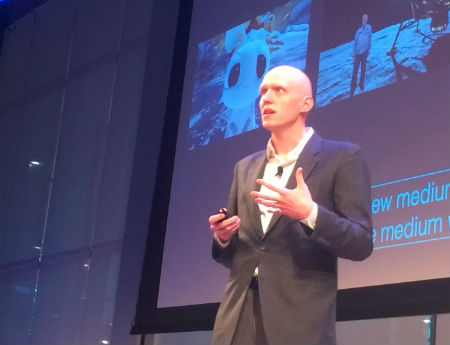VR 20/20: AltspaceVR CEO Predicts The Road Ahead

Get complete coverage of NYC Television & Video Week.
New York – Predicting the future is a tricky thing, but it was a task taken on here Monday by Eric Romo, the co-founder and CEO of social virtual reality startup AltspaceVR.
Romo, the closing keynoter at VR 20/20, the first event for NewBay Media’s NYC Television & Video Week, offered his view on how key elements of the virtual reality (and augmented reality) market look today, and how they will evolve and change in the next three-plus years.
“The big challenge [for the industry] is too much looking forward,” Romo said, before reeling off this quote from Mark Twain: “Whenever you find yourself on the side of the majority, it is time to pause and reflect.”
RELATED: NBC News, AltspaceVR Team on ‘Virtual Democracy Plaza’
Today, he noted, many investment firms have a "VR person,” the individual who understands what all this new stuff is about. He noted that this similarly played out during the early days of the Internet, “Web 2.0” and mobile, for example. Today, the notion that one person at any one company encapsulates any of those is “ridiculous,” he said, because they eventually became huge, enabling technologies.
RELATED: VR 20/20: Unknowns Abound in Virtual and Augmented Reality Market
Multichannel Newsletter
The smarter way to stay on top of the multichannel video marketplace. Sign up below.
“And VR is the same,” Romo said, noting that companies will embrace and use VR as a foundational technology “or suffer.” In 2020, there will no longer be “VR companies,” but companies that use VR to solve a problem, he said.
Today, Romo said, 360-degree video is the dominant form of “passive” VR content that happens to work across all platforms. “People sort of know how to make it already,” he said of that category of content. In 2020, he predicted, new forms of “semi-passive” content will emerge and VR itself will become a new medium under which purpose-built content will flourish.
Today, everyone shows the “sunglasses slide,” representing the merging of VR and AR in a way that resembles a pair of Wayfarers. In 2020, he said, the sunglasses slide will be dropped as VR and AR “diverge” further and become more useful and support more markets and specific applications.
Today, Romo pointed out, consumers receive VR content by pairing viewers with mobile phones, gaming consoles or high-powered PCs. If the industry is being honest with itself, it will admit that this is a “broken” model for most. Romo predicted that in 2020 stand-alone platforms “optimized for VR” will become dominant and outsell today’s approaches, offering up Oculus’s Santa Cruz project and the Qualcomm Snapdragon VR820 and Intel’s “Alloy” reference platforms among examples of standalone-facing projects that are already well underway.
Today, Romo noted, the “Metaverse” – generally defined as a collective, virtual shared space -- is viewed as a place someone will build, based on what’s been proposed in books such as William Gibson’s Neuromancer, Ernest Cline’s Ready Player One or Neal Stephenson's Snow Crash. The Metaverse that will emerge in 2020, Romo said, will embody “the evolution of the Internet” and will become something different than anything being imagined today. It will not be purposefully built, he said, but will instead materialize from the hard work of disparate groups, all trying to deliver great experiences.
“It’s organic…it’s an evolution,” Romo said.
